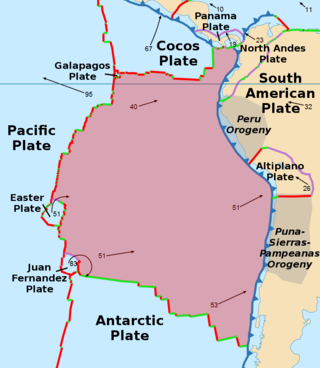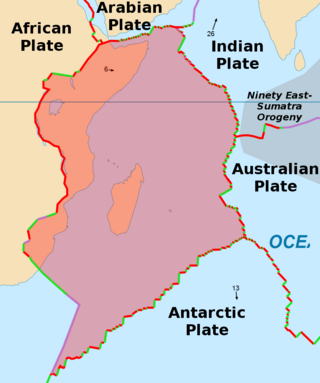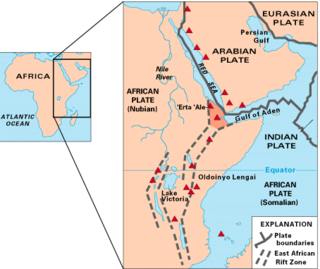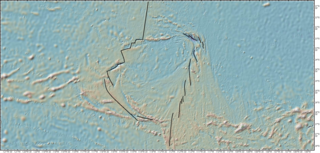
The Nazca Plate or Nasca Plate, named after the Nazca region of southern Peru, is an oceanic tectonic plate in the eastern Pacific Ocean basin off the west coast of South America. The ongoing subduction, along the Peru–Chile Trench, of the Nazca Plate under the South American Plate is largely responsible for the Andean orogeny. The Nazca Plate is bounded on the west by the Pacific Plate and to the south by the Antarctic Plate through the East Pacific Rise and the Chile Rise respectively. The movement of the Nazca Plate over several hotspots has created some volcanic islands as well as east–west running seamount chains that subduct under South America. Nazca is a relatively young plate both in terms of the age of its rocks and its existence as an independent plate having been formed from the break-up of the Farallon Plate about 23 million years ago. The oldest rocks of the plate are about 50 million years old.
Plate readers, also known as microplate readers or microplate photometers, are instruments which are used to detect biological, chemical or physical events of samples in microtiter plates. They are widely used in research, drug discovery, bioassay validation, quality control and manufacturing processes in the pharmaceutical and biotechnological industry and academic organizations. Sample reactions can be assayed in 1-1536 well format microtiter plates. The most common microplate format used in academic research laboratories or clinical diagnostic laboratories is 96-well with a typical reaction volume between 100 and 200 µL per well. Higher density microplates are typically used for screening applications, when throughput and assay cost per sample become critical parameters, with a typical assay volume between 5 and 50 µL per well. Common detection modes for microplate assays are absorbance, fluorescence intensity, luminescence, time-resolved fluorescence, and fluorescence polarization.

A microplate, also known as a microtiter plate, microwell plate or multiwell, is a flat plate with multiple "wells" used as small test tubes. The microplate has become a standard tool in analytical research and clinical diagnostic testing laboratories. A very common usage is in the enzyme-linked immunosorbent assay (ELISA), the basis of most modern medical diagnostic testing in humans and animals.

The Somali Plate is a minor tectonic plate which straddles the Equator in the Eastern Hemisphere. It is currently in the process of separating from the African Plate along the East African Rift Valley. It is approximately centered on the island of Madagascar and includes about half of the east coast of Africa, from the Gulf of Aden in the north through the East African Rift Valley. The southern boundary with the Nubian-African Plate is a diffuse plate boundary consisting of the Lwandle Plate.

The East African Rift (EAR) or East African Rift System (EARS) is an active continental rift zone in East Africa. The EAR began developing around the onset of the Miocene, 22–25 million years ago. It was formerly considered to be part of a larger Great Rift Valley that extended north to Asia Minor.
The Tonga Plate is a small southwest Pacific tectonic plate or microplate. It is centered at approximately 19° S. latitude and 173° E. longitude. The plate is an elongated plate oriented NNE - SSW and is a northward continuation of the Kermadec linear zone north of New Zealand. The plate is bounded on the east and north by the Pacific Plate, on the northwest by the Niuafo’ou Microplate, on the west and south by the Indo-Australian Plate. The Tonga plate is subducting the Pacific plate along the Tonga Trench. This subduction turns into a transform fault boundary north of Tonga. An active rift or spreading center separates the Tonga Plate from the Australian Plate and the Niuafo’ou microplate to the west. The Tonga Plate is seismically very active and is rotating clockwise.

Ruvuma River, formerly also known as the Rovuma River, is a river in the African Great Lakes region. During the greater part of its course, it forms the border between Tanzania and Mozambique. The river is 998 kilometres (600 mi) long, with a drainage basin of 155,500 square kilometres (60,000 sq mi) in size. Its mean annual discharge is 475 m3/s (16,800 cu ft/s) at its mouth.
The Intermontane Plate was an ancient oceanic tectonic plate that lay on the west coast of North America about 195 million years ago. The Intermontane Plate was surrounded by a chain of volcanic islands called the Intermontane Islands, which had been accumulating as a volcanic chain in the Pacific Ocean since the Triassic period, beginning around 245 million years ago. The volcanism records yet another subduction zone. Beneath the far edge of the Intermontane microplate, another plate called the Insular Plate was sinking. This arrangement with two parallel subduction zones is unusual. The modern Philippine Islands are located on the Philippine Mobile Belt, one of the few places on Earth where twin subduction zones exist today. Geologists call the ocean between the Intermontane islands and North America the Slide Mountain Ocean. The name comes from the Slide Mountain Terrane, a region made of rocks from the floor of the ancient ocean.

The Galapagos Microplate (GMP) is a geological feature of the oceanic crust located at 1°50' N, offshore of the west coast of Colombia. The GMP is collocated with the Galapagos Triple Junction, which is an atypical ridge-ridge-ridge triple junction. At the Galapagos Triple Junction, the Pacific Plate, Cocos Plate, and Nazca Plate meet incompletely, forming two counter-rotating microplates at the junction of the Cocos-Nazca, Pacific-Cocos, and Pacific-Nazca spreading ridges.

The South Sandwich Plate or the Sandwich Plate is a small tectonic plate (microplate) bounded by the subducting South American Plate to the east, the Antarctic Plate to the south, and the Scotia Plate to the west. The plate is separated from the Scotia Plate by the East Scotia Rise, a back-arc spreading ridge formed by the subduction zone on its eastern margin. The South Sandwich Islands are located on this microplate.

Easter Plate is a tectonic microplate located to the west of Easter Island off the west coast of South America in the middle of the Pacific Ocean, bordering the Nazca Plate to the east and the Pacific Plate to the west. It was discovered from looking at earthquake distributions that were offset from the previously perceived Nazca-Pacific Divergent boundary. This young plate is 5.25 million years old and is considered a microplate because it is small with an area of approximately 160,000 square kilometres (62,000 sq mi). Seafloor spreading along the Easter microplate's borders have some of the highest global rates, ranging from 50 to 140 millimetres /yr.

The Azores Triple Junction (ATJ) is a geologic triple junction where the boundaries of three tectonic plates intersect: the North American Plate, the Eurasian Plate and the African Plate. This triple junction is located along the Mid-Atlantic Ridge (MAR) amidst the Azores islands, nearly due west of the Strait of Gibraltar. It is classed as an R-R-R triple junction of the T type, as it is an intersection of the Mid-Atlantic Ridge running north–south and the Terceira Rift which runs east-southeast.

The Juan Fernandez Plate is a small tectonic plate (microplate) in the Pacific Ocean. With a surface area of approximately 105 km2, the microplate is located between 32° and 35°S and 109° and 112°W. The plate is located at a triple junction between the Antarctic Plate, the Nazca Plate, and the Pacific Plate. Approximately 2,000 km to the west of South America, it is, on average, 3,000 meters deep with its shallowest point coming to approximately 1,600 meters, and its deepest point reaching 4,400 meters.

The Panama Plate is a small tectonic plate (microplate) that exists between two actively spreading ridges and moves relatively independently of its surrounding plates. The Panama Plate is located between the Cocos Plate and the Nazca Plate to the south and the Caribbean Plate to the north. Most of its borders are convergent boundaries, including a subduction zone to the west. It consists, for the most part, of the countries of Costa Rica and Panama.

The Gonâve Microplate forms part of the boundary between the North American Plate and the Caribbean Plate. It is bounded to the west by the Mid-Cayman Rise spreading center, to the north by the Septentrional-Oriente fault zone and to the south by the Walton fault zone and the Enriquillo–Plantain Garden fault zone. The existence of this microplate was first proposed in 1991. This has been confirmed by GPS measurements, which show that the overall displacement between the two main plates is split almost equally between the transform fault zones that bound the Gonâve microplate. The microplate is expected to eventually become accreted to the North American Plate.

The Tisza Plate is a tectonic block, or microplate, in present-day Europe. The two major crustal blocks of the Pannonian Basin, Pelso and Tisza, underwent a complex process of rotation and extension of variable magnitude during the Cenozoic era. The northward push of the Adriatic Block initiated the eastward displacement and rotation of both the Alcapa and Tisza blocks. The Zágráb-Hernád line is the former plate margin between the Pelso of African origin and the Tisza Plate of Eurasian origin.

The North Galapagos Microplate is a small tectonic plate off the west coast of South America north of the Galapagos Islands. It is rotating counterclockwise between three much larger crustal plates around it, the Nazca, Cocos and Pacific Plates. To its south, another small microplate, the Galapagos Microplate is likewise rotating, but clockwise. Both microplates "mesh" along the interface between them.

The Lwandle Plate is one of three tectonic microplates, along with the Rovuma Plate and Victoria Plate, that make up the African Plate with the Somali Plate and the Nubian Plate. Its discovery is very recent, so the velocity of the plate is neither well known nor well understood. Many experiments are ongoing to quantify this. The Lwandle Plate lies between 30°E and 50°E, sharing a boundary with the Nubian, Somali, and Antarctic Plates.

The Victoria Microplate or Victoria Plate is a small tectonic plate in East Africa. It is bounded on all sides by parts of the active East African Rift System. It is currently rotating anticlockwise. Its boundaries are close to those of the mainly Archaean Tanzania Craton, with the two arms of the rift system having propagated along the surrounding Proterozoic shear belts. To the northwest, west and southwest it has a boundary with the Nubian Plate, to the northeast and east with the Somali Plate and to the southeast with the Rovuma Plate.
















